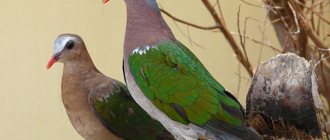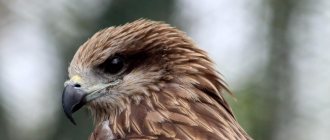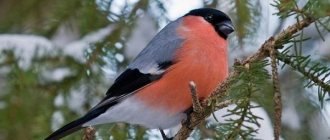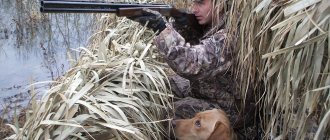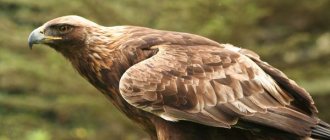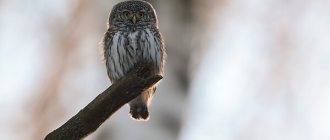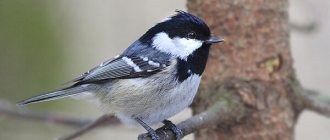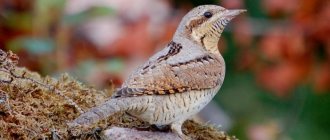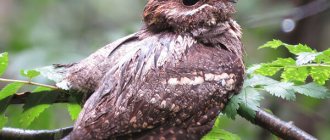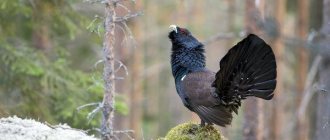- Wild animals
- >>
- Birds
The blue tit is a small, very showy-looking bird that is a type of great tit. People also call her “princeling”. In size, the blue tit is slightly inferior to its relative, but in all other respects it is very similar to it. A person who does not have knowledge of ornithology will probably not distinguish these two birds from each other.
Appearance
The blue tit is a very bright bird that immediately catches your eye. Its main difference from its other brothers is its bright blue plumage. As mentioned above, the blue tit is not large in size, so it is not surprising that nature has endowed it with a short beak and tail. It has external similarities with the tit bird, however, the blue tit is much smaller than the tit. The blue tit can be distinguished from other representatives of its family by its bright blue plumage with a greenish tint. In addition, unlike all tits, she not only has a black mask on her head, but also a dark blue stripe wrapping around her neck.
These are the main differences between this little one and its fellows, otherwise it is no different from a typical tit. She has a white forehead and cheeks, a bright blue tail and wings, an olive green back and a greenish-yellow belly. The blue tit's head is decorated with a short dark beak and small grayish paws complete its appearance. Blue tits are distinguished by their mobility and flight speed, however, since their wings are not large, they have to flap them more often.
Blue tit bird sitting on a stone
Moskovka
This bird resembles a great tit, but has a cooler coloration and a dense body. Experts believe that the dark cap, or mask, on its head gave the bird its original name - masked bird. Later, the word began to be written with an “o”, in association with the name of the city. The species is listed in the Red Book of Moscow under the second category of rarity.
Differences between females and males
As with many birds, a female blue tit can be distinguished from a male primarily by the size of the bird. Females are significantly smaller than males. Another distinguishing feature is coloring. As already described above, the blue tit has quite bright, catchy, and in some ways even aggressive plumage. However, this description is only suitable for males. Females are distinguished by calmer tones in their plumage. Although the general distribution of colors is identical between individuals, it is less bright in females.
Sweet couple
Where do they live?
The small bright bird can be found in almost every corner of Europe today. The exceptions are Iceland, northern Scotland, the Alps, the Balkans, northern Russia and Scandinavia. The reason for this is that the climate is too cold, which is completely unsuitable for them to live comfortably.
For life, these birds prefer to choose oak forests, however, this is an ideal option, which today, unfortunately, is not always achievable. Therefore, the blue tit had to learn to live in different living conditions, however, it can still live only where there is an abundance of deciduous trees. Blue tits have been so successful in adapting to new living conditions that today they are found in cities and are almost not afraid of people.
Some species of this bird live in northern Africa, where there are oak and cedar forests that are ideal for them to live. They are also found in oases in the Sahara.
Blue tit bird in all its glory
What types are there and their differences
Today, about sixty-five species of different tits have already been identified. All of them are united by low weight and size. Here are some of them:
Big
Another name for the bird is bolshak or grasshopper. Like all representatives of this family, the grasshopper has beautiful plumage. She has a light green back with yellow spots and a yellow belly. You can distinguish the Great Tit from other tits by the black stripe along the belly and chest. Black color is also present on the top of its head, on the side of its neck, tail and neck.
Great Blue Tit
Hanging
This is the smallest representative of the tit family. Its tiny wing does not exceed fifty millimeters in length. Unlike its brothers, this titmouse has very inconspicuous plumage and makes it as inconspicuous as possible. The bird's body has yellowish-gray feathers. And this little one lives in Africa, namely in its southern and southwestern parts.
Mustachioed
In another way, this bird is also called bearded due to the presence of a black “beard” on the white throat of the males. These are very beautiful representatives of the tit family. Their light brown plumage with a yellowish tint will never be forgotten. Their head is gray with a blue tint.
Photo of a whiskered tit
Crested
This bird also has another name - grenadier. Another very interesting species of tit. If you meet this bird, you will immediately notice its crest, due to which it was given its name. The plumage of the tit itself is very inconspicuous: its body is brownish in color, there are black spots on the throat and sides, the belly is white, but the crest stands out against the background of such a body with its black and white color.
Tufted titmouse bathes in the morning sun
Moskovka
This titmouse is also called black for the predominant color in its plumage. In some ways it resembles a great tit, however, the Muscovy is much smaller. She has a black cap, and cheeks with white spots, her back is gray with a bluish tint, but her tummy and chest are light gray with a reddish tint.
Muscovy bird on a pebble
Puffy
This representative of tits also has the names chickadee or marsh tit. Just like some other species of this family, it has a rather inconspicuous color: a black cap, a light gray back, a dirty white belly, and dark brown wings and tail.
Titmouse plump
Oppolonovka
Another smallest representative of the tit family living in Russia. However, despite its size, it has a very long and beautiful brown-black tail, a white head and belly, and dark brown wings.
Bird opolonovka
Who is this titmouse?
One of the most mysterious and nimble living creatures are “feathered creatures,” that is, birds. They float somewhere in the clouds and just don’t fall into your hands. There are no domesticated, tame birds, not counting those that humans have tamed through food and training or taught to live in cages:
- parrots,
- canaries,
- pigeons
However, despite all their obstinacy and agility, birds soaring in the sky will always evoke admiration from humans. And when birds sing in clear voices early in the morning, people feel the happiness and harmony of this world.
One of these singers is the tit. When she sings, it creates the sensation of ringing bells. It is this magnificent bird that, with its singing, is trying to tell all people that spring will come soon.
What do blue tits eat?
The diet of this bird is very varied, but mostly consists of insects, and to a lesser extent they eat berries and fruits. Moreover, their diet depends on the time of year. So, in the summer they focus more on insects, and in the fall they switch to various berries.
The blue tit develops a special appetite for insects during the period of feeding its chicks. Which, by the way, is of great benefit to gardeners, because this little thing rids fruit trees of various pests.
In winter, these birds diligently search for insects in the bark of trees, and urban feathered inhabitants feed in feeders set up by people. They do not hesitate to rummage through human garbage in search of food during cold weather.
Blue tit on rowan tree
Food
The blue tit's menu consists of 78 percent small bugs and spiders (up to 1 centimeter) and their larvae. The diet varies depending on the location and season of the year. In the spring, when the trees begin to bloom, the blue tit feeds mainly on spiders. Then the caterpillars begin to appear, they also go to feed (especially when the caterpillars become fat, large and juicy). More precisely, the caterpillars become the main menu. and the spiders fade into the background. The blue tit is a tireless fighter against forest pests. It plagues large quantities of aphids, caterpillars, bedbugs and other small bugs. Flying insects also come to the table - flies, mosquitoes, wasps, beetles, centipedes.
Video “The blue tit (Cyanistes caeruleus) sings”
In autumn, the bird switches to plant foods. The insects are already hibernating, and the bird eats plant seeds (pine, spruce, birch, maple, oak, cypress and others).
And of course, blue tits fly closer to humans. After all, here you can enjoy yourself or simply not die of hunger. They eat seeds, nuts, pieces of food. Any food that a person feeds it. Often the blue tit, together with the tits, eat sunflower seeds from the feeder and pieces of bread, lard, and pecks at wrapped dried fruits on the balcony.
What blue tit nests look like
Blue tits usually choose hollows for their nests that already exist in trees that are at least two meters from the ground. This height is chosen in order to protect future chicks from various dangers. Future parents bring flexible branches, grass, moss, feathers and wool into this hollow to build their nest. What is interesting is that only the female builds the nest.
Blue tits can lay eggs twice in a season. In one clutch, as a rule, you cannot find more than a dozen eggs, which, like the birds themselves, are not large in size. The further division of responsibilities associated with parenthood is similar to humans: the female takes care of the chicks, and the male provides food for everyone.
However, even though the chicks hatch naked, they are not with their parents for long. Within a couple of weeks they have full plumage, and a new generation of tits sets off into adulthood, and the parents are already preparing for a new replenishment.
Nest with chicks in a birdhouse
The House That Jack Built
In forests, blue tits find hollow trees. They often choose ready-made hollows of other birds or various cracks (frost holes, rotten cores) in the wood. In them they make nests for themselves from moss, dry branches and blades of grass, and the hair of wild and domestic animals. It has been noted that blue tits willingly take advantage of the benefits of civilization and line their nests with cotton wool and pieces of paper.
Blue tits are smaller than other tits and choose tighter hollows with narrow (25 mm) entrances. This should be used when building a house for the blue tit. A good option for an artificial dwelling was proposed by K.N. Blagoslonov in his book:
Diagram of a titmouse from the book by K.N. Blagosklonova.
It is noteworthy that blue tits often complete their new home. They can expand the cavity chamber, or clean the edges of the entrance if the bird does not like its size and shape.
Unusual blue tit dwellings:
- lamp posts and other metal pipes;
- earthen hole - the case was described in the Ivano-Frankivsk region;
- other people's nests. A case of a wren's nest being captured was described by J. Corlet, and V.A. Koshcheev discovered them in the house of the city swallow.
Blue tit bird at home
The blue tit is kept at home very rarely, however, if this happens, then it needs to be provided with a spacious enclosure. Its place of life must be equipped with various perches, branches and other entertainment so that the tit does not get bored and begin to irritate the owner with its constant chirping.
Feeding the Blue Tit must also be approached with full responsibility. Since this bird is considered an omnivore, it should not be fed grain alone under any circumstances. The bird needs a complete diet, which means protein foods should also be present in its diet.
In addition, it is better to equip the aviary with a fairly spacious bath of water, since the blue tit is a very clean bird and loves water treatments.
But putting it in the same enclosure with other birds may be a mistake, since these birds practically do not get along with other species and are very hostile towards them. At the same time, you should not worry about the bird’s long adaptation to captivity; the blue tit gets used to this in a matter of hours.
The titmouse flies to the hand
Interesting Facts
- In Rus', exterminating tits was strictly prohibited, since people have long known about the great benefits these little ones bring to humans. By the way, failure to comply with the ban was punished very, very severely;
- Contrary to popular belief, the tit received its name not for its bright plumage, but for the sounds it makes;
- The tit feeds its chicks very intensively. Their offspring receive food about thirty-five times an hour;
- In England, when milk was still delivered to homes in person, blue tits found out about this and flew in every morning to feast on the cream from milk bottles;
- For their nests, blue tits not only use natural materials, but also borrow some things from people. When building a nest, window putty or pieces of wallpaper that the bird brazenly “stole” from people can be used;
- The blue tit has a fairly well-developed sense of smell. This bird recognizes some smells almost on a par with humans;
- When the blue tit already has chicks, they are able to imitate some sounds when the nest is in danger. For example, the hissing of a snake or the buzzing of bees.
Tit bird in flight
Listen to the blue tit sing
The audio tag is not supported by your browser. Close
The troubles of avian motherhood
Preparation of the blue tit's nesting chamber begins at the end of March - beginning of April, and from the second ten days of April the female begins to build a nest, the construction of which takes from 10 to 15 days. The bottom of the nesting chamber is abundantly covered with green moss, the thickness of which in some cases can exceed 15 cm.
Blue tits are excellent parents. The birds incubate the clutch for 15-16 hours a day, spending the whole night, as well as a significant part of the day, on the eggs. Only in the morning and evening hours is increased feeding activity of the female observed, when she leaves the nest in search of food. And with the hatching of chicks, the worries only increase: the blue tit brings food to its babies from 300 to 100 times per day (depending on the age and number of chicks in the brood).
At the beginning of incubation, the female is easy to frighten off - she will fly out of the hollow and grumpily shout a threat at a person or friend. But a few days before hatching, the female will prefer to actively protect her future offspring - she will not leave the hollow, even if the ornithologist sticks his hand into it.
Interesting: sometimes a pair of blue tits helps a pair of tits nesting nearby to feed their chicks. Great tits alternately carry food for their chicks either into their own hollow or into the neighboring one occupied by blue tits. The reasons for this behavior are unclear.

